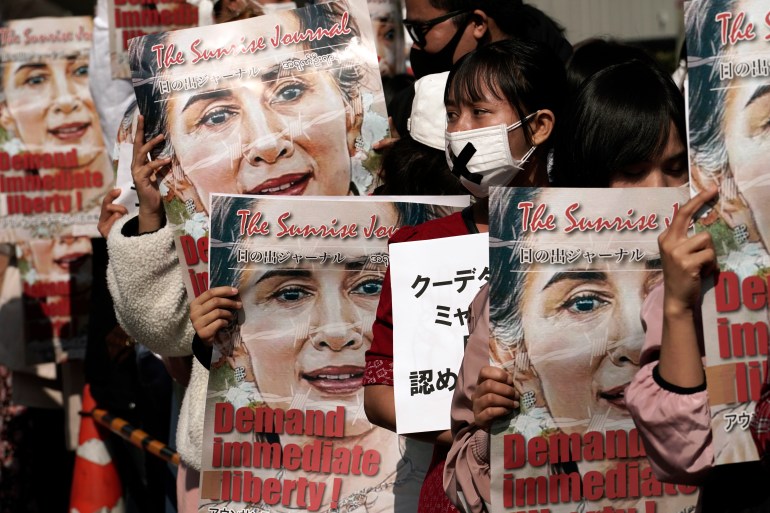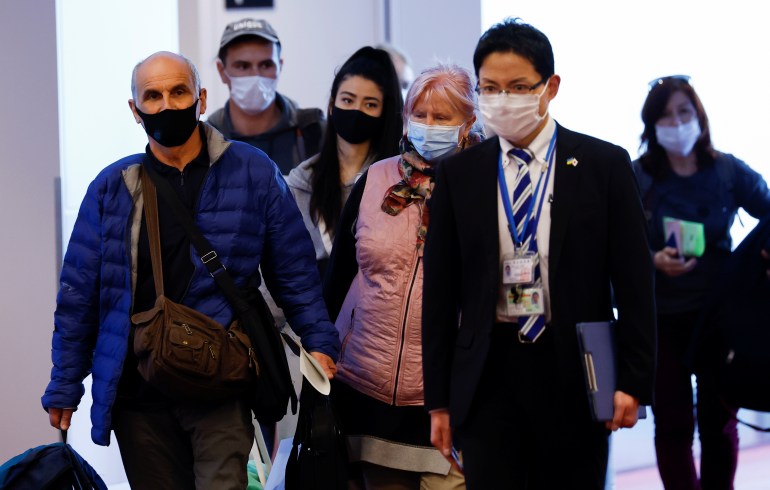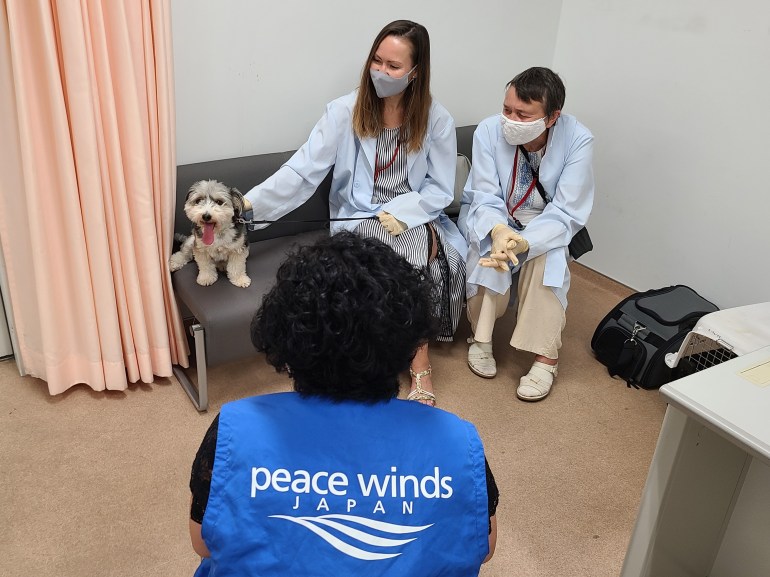Myanmar, Ukraine war shift Japanese policy on refugees
The crisis in Myanmar and Russia’s invasion of Ukraine have opened Japan’s door a fraction wider.

Tokyo, Japan – Since the Japan Association for Refugees (JAR) was founded in 1999, it has helped more than 7,000 asylum seekers from at least 70 countries.
But over the same period, the Japanese government’s average approval rate of refugee applications – about 30 people a year – has scarcely changed, despite the country’s wealth and a surge in the number of people needing protection worldwide.
Keep reading
list of 4 itemsJapan pledges $30bn in aid for Africa at Tunisia conference
Japan to spend $1.83m on ex-PM Abe’s state funeral
Japan’s police chief to resign over Shinzo Abe assassination
Russia’s war in Ukraine might be helping to change things.
Within days of the invasion, Prime Minister Fumio Kishida had promised to accept asylum-seeking friends and relatives of the 1,900 Ukrainians already living in Japan. Justice Minister Yoshihisa Furukawa added a month later that “the government as a whole will continue to provide close assistance to evacuees.”
Both statements suggested an about-face for Japan’s refugee strategy.
Since it ratified the 1951 Refugee Convention in the wake of the Vietnam War, Japan has taken a low-key approach to refugees, giving a home to a fraction of those offered protection by other developed nations.
While refugee admittance rates had been decreasing in the United States, so far this year more than 15,000 applications have been granted. The United Kingdom also grants more than 10,000 people asylum in an average year, as do major European Union economies including Germany, France and Italy.
JAR’s board chair, Eri Ishikawa, says the application process in Japan is too slow, using the case of an anonymous asylum seeker, ‘Mr A’ from Myanmar, to illustrate her point.
“[He] applied for asylum 10 years ago and is still waiting for his claim to be granted. He does not have legal status, so he could be detained at any time by immigration,” Ishikawa told Al Jazeera. “He is not entitled to social security, such as national health insurance, or allowed to work.”
In 2021, 2,413 refugee applications were submitted to Japan’s Immigration Agency, with 74 accepted. That might not seem like many, but spurred by people from Myanmar seeking protection from religious persecution and last year’s military coup, it was more than double the number in any typical year.

Japan, the third-largest national donor to the UN refugee agency with contributions of $140m in 2021, first began a pilot resettlement programme for Myanmar refugees in 2010. Working in coordination with the UN High Commissioner for Refugees (UNHCR), it took in 90 refugees over the first three years of the programme.
In April this year, Japan announced that those unable to return to Myanmar due to political instability could remain in the country under “emergency measures”.
The measures, based on Japan’s interpretation of the Refugee Convention, grant temporary legal status and work permits, which may be restricted to 28 hours per week, for either six months or one year. In 2021, about 3,600 people were living in the country as a result of the measures.
Despite the violent crackdown following the coup, Japan does not yet accept Myanmar refugees from abroad unless they are resettled through the UNHCR programme. According to data from June 2021, fewer than 200 people had been granted formal refugee status via this pathway. This has adverse knock-on effects on Myanmar’s struggling ethnic groups, such as the mostly Muslim Rohingya, who have been described by the UN as “the most persecuted minority in the world”.
Ukrainian ‘evacuees’
The war in Ukraine has shone further light on Japan’s refugee strategy, with the Immigration Agency saying Ukrainians had been arriving since February when Russia began its invasion.

The Japanese government refers to these people as “evacuees”, however, because their refugee status is considered informal. The Ukrainians have also been allowed to stay under the “emergency measures” and have been provided with one-year legal residency and work permits, which are subject to renewal.
JAR’s Ishikawa says the term “evacuees” has “blurred the application of rights” that Ukrainian refugees should be afforded, including non-refoulement, under which no individual can be returned to a country where they are at risk of persecution.
Despite Japan’s traditional reticence, the Kishida cabinet has taken unprecedented measures towards supporting Ukraine, including $600m in aid and a private government jet which brought 20 displaced Ukrainians to Japan.
This has been echoed in the public sphere, with numerous protests and fund-raising events across the country, and widespread expressions of solidarity with Ukraine on the 77th anniversary of the end of World War II in August.
Natsuko Takenaka, who is in charge of supporting Ukrainian evacuees at Peace Winds Japan, has noticed an attention shift in relation to the crisis in Ukraine, which she says the Japanese public is “very willing to support”.
A non-governmental organisation (NGO), Peace Winds Japan, works with partner organisations to offer assistance on the ground in Ukraine and neighbouring Moldova, and has helped 19 Ukrainian families seeking asylum in Japan. Peace Winds focuses on helping refugees with pets, as the logistical barriers for bringing animals to Japan are significant – including up to 180 days of quarantine and mandatory rabies tests – and the associated costs are typically high.
Takenaka says employment is another key area as “language can be a barrier for refugees to utilise their skill sets, talent or experience.” This has forced some to seek opportunities through the Hello Work employment office, Japan’s centre for job seekers, which usually places them in blue-collar and entry-level roles.
According to the Nippon Foundation, which surveyed 260 refugees coming to Japan from Ukraine, Japanese language education was noted as the single most important need, with job opportunities and occupational training second, and medical care third, all of which are priorities for Japan’s NGOs.
“It is very difficult for refugees to adjust to the differences in language and culture, and to work and make a living,” said JAR’s Ishikawa. “In addition, the conflict and persecution in their home countries, which is the reason they became refugees, is not expected to improve in a short period of time.”
Politically-driven policy
The slight loosening of Japan’s refugee policy is widely believed to be political although Ukraine and Myanmar “are not equivalent”, according to Stephen Nagy, a professor of politics and international studies at the International Christian University in Tokyo.
“[Myanmar] is seen as a country rich in natural resources and a geopolitical pivot point connecting Southeast Asia and South Asia,” he said. “Japan wants to build a strong relationship with whatever government is in power and to prevent China from dominating or turning Myanmar into a client state … Accepting a small number of refugees from Myanmar has been a part of that.”
Japan’s “existential concerns” that China could emulate Russia by launching an invasion in the Indo-Pacific, meanwhile, has influenced its support for Ukraine, Nagy told Al Jazeera.
“Accepting Ukrainian refugees, students and public servants for training is part of Japan’s contributions to continue to make Ukraine a viable state and push back against Russia’s explicit use of military power to change the international order that Japan and other middle powers benefit from,” he said.

While analysts concede that some progress has been made – a claim lent further credence when Japan granted 98 Afghan refugee applications on August 19 – many view the emergency status of refugees in Japan as just a temporary measure, mirroring the 11,000 people granted entry after being forced from their homes as a result of the Vietnam War.
With drastic policy changes not yet on the horizon, Eri Ishikawa believes that, for now, the emphasis needs to be at the individual level.
“It’s necessary to provide comprehensive integration support to those who have been accepted into Japan, including food, clothing, shelter, and access to medical care, as well as livelihood support so that they can live in Japan with a long-term perspective,” she said. “Since each refugee is in a different situation, individual consultation and response is necessary.”